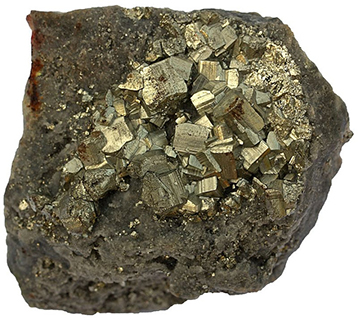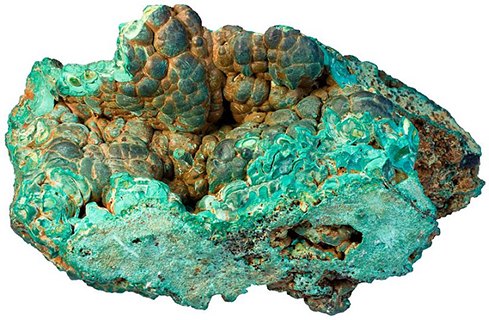Part D
Economic Minerals
Many materials used in today's modern industrial society are derived from one of Earth's natural mineral resources. A mineral resource is a natural concentration of a material that is economically feasible to mine. Mineral resources that contain metallic elements (copper, silver, iron, etc.) are found in the earth's crust and can combine with sulfur to form the mineral group known as sulfides. Pyrite (iron sulfide) and galena (lead sulfide) are examples of sulfide minerals. When a sulfide ore deposit weathers (exposed to air and water), it produces a new group of minerals known as the oxides (metals that combine with oxygen). In general, oxide minerals are recognized by their distinct colors (like azurite-blue, malachite-green, hematite-reddish, etc.), and sulfide minerals are recognized by their metallic appearance (luster).
|
Figure 4-16. There are many varieties of economic minerals, including two important groups: sulfides and oxides. At left, the sulfide mineral pyrite forming what is known as a volcanogenic massive sulfide deposit. At right,the oxide mineral malachite commonly occurs as botryoidal (spherical ) shapes (the width of this sample is 12 cm). Both images courtesy of courtesy sandatlas.org. |
|
Descriptions of Common Economic Minerals
![]() Pyrite / FeS2 / Metallic luster. Brassy yellow color that can tarnish brown. Often massive or forms cubes. Dark gray streak. H = 6.5-6. Specific gravity = 5.0. Commonly known as "fools gold". An iron sulfide.
Pyrite / FeS2 / Metallic luster. Brassy yellow color that can tarnish brown. Often massive or forms cubes. Dark gray streak. H = 6.5-6. Specific gravity = 5.0. Commonly known as "fools gold". An iron sulfide.
![]() Chalcopyrite / CuFeS2 / Metallic luster. Golden to brassy yellow color that can tarnish bluish-purple. Commonly massive. Dark gray streak. H = 4-3.5. Specific gravity = 4.1-4.3. A copper-iron sulfide.
Chalcopyrite / CuFeS2 / Metallic luster. Golden to brassy yellow color that can tarnish bluish-purple. Commonly massive. Dark gray streak. H = 4-3.5. Specific gravity = 4.1-4.3. A copper-iron sulfide.
![]() Galena / PbS / Metallic luster. Silver color that can tarnish dull gray. Forms cubic crystal and breaks into cubes from three cleavage planes at right angles. H = 2.5. Specific gravity = 7.6 (high). A lead sulfide.
Galena / PbS / Metallic luster. Silver color that can tarnish dull gray. Forms cubic crystal and breaks into cubes from three cleavage planes at right angles. H = 2.5. Specific gravity = 7.6 (high). A lead sulfide.
![]() Cinnabar / HgS / Non-metallic luster. Distinctive brownish-red color. Scarlet streak. H = 2.5-2. Specific gravity = 8.0-8.2. A mercury sulfide.
Cinnabar / HgS / Non-metallic luster. Distinctive brownish-red color. Scarlet streak. H = 2.5-2. Specific gravity = 8.0-8.2. A mercury sulfide.
![]() Orpiment / As2S3 / Non-metallic luster. Distinctive yellow to orange color. Light lemon yellow streak. H = 2-1.5. Specific gravity = 3.5. An arsenic sulfide.
Orpiment / As2S3 / Non-metallic luster. Distinctive yellow to orange color. Light lemon yellow streak. H = 2-1.5. Specific gravity = 3.5. An arsenic sulfide.
![]() Native copper / Cu / Metallic luster. Copper color (like a new penny), but tarnishes dull brown or green (like an old penny). Malleable (can be bent without breaking, like wire); generally massive or dendritic (root-like). Copper-colored streak. H = 3-2.5. Specific gravity = 8.8 (high). A native element.
Native copper / Cu / Metallic luster. Copper color (like a new penny), but tarnishes dull brown or green (like an old penny). Malleable (can be bent without breaking, like wire); generally massive or dendritic (root-like). Copper-colored streak. H = 3-2.5. Specific gravity = 8.8 (high). A native element.
![]() Hematite / Fe2O3 / Metallic to non-metallic luster. Metallic gray to earthy red color. Red to red-brown streak. H = 5.5. Specific gravity = 5.3-4.9. An iron oxide.
Hematite / Fe2O3 / Metallic to non-metallic luster. Metallic gray to earthy red color. Red to red-brown streak. H = 5.5. Specific gravity = 5.3-4.9. An iron oxide.
![]() Magnetite / Fe3O4 / Metallic luster. Dark gray to black color. Dark gray streak. H = 6. Specific gravity = 5.2. Magnetic. An iron oxide.
Magnetite / Fe3O4 / Metallic luster. Dark gray to black color. Dark gray streak. H = 6. Specific gravity = 5.2. Magnetic. An iron oxide.
![]() Azurite / Cu3(CO3)2(OH)2 / Nonmetallic luster. Distinctive light to deep blue color. Generally forms earthy masses. Light blue streak. Reacts with dilute HCl acid. H = 4-3.5. Specific gravity = 2.7-3.1 (low). A copper oxide.
Azurite / Cu3(CO3)2(OH)2 / Nonmetallic luster. Distinctive light to deep blue color. Generally forms earthy masses. Light blue streak. Reacts with dilute HCl acid. H = 4-3.5. Specific gravity = 2.7-3.1 (low). A copper oxide.
![]() Chrysocolla / CuSiO3*H2O / Nonmetallic luster. Distinctive pale blue-green or turquoise color. Generally forms earthy or shiny masses. Very light blue streak. H = 4-2. Specific gravity = 2.0-2.4 (low). A copper oxide.
Chrysocolla / CuSiO3*H2O / Nonmetallic luster. Distinctive pale blue-green or turquoise color. Generally forms earthy or shiny masses. Very light blue streak. H = 4-2. Specific gravity = 2.0-2.4 (low). A copper oxide.
![]() Malachite / Cu2(CO3)(OH)2 / Nonmetallic luster. Distinctive pale to dark green color. Generally forms laminated to earthy masses. Green streak. Reacts with dilute HCl acid. H = 4-3.5. Specific gravity = 3.9-4.0. A copper oxide.
Malachite / Cu2(CO3)(OH)2 / Nonmetallic luster. Distinctive pale to dark green color. Generally forms laminated to earthy masses. Green streak. Reacts with dilute HCl acid. H = 4-3.5. Specific gravity = 3.9-4.0. A copper oxide.
Ore Mineral Compositions
Let's answer a few questions about ore mineral compositions.
![]()
![]()
Economic Mineral Identification
Like the rock-forming minerals, most economic minerals can be identified using a few important physical properties, like color, luster, hardness, etc. Again, it's not hard to identify most common minerals when you organize your observations of the important physical properties into a flow-chart-like decision tree. You can use the same identification methodology that you used to identify the rock-forming minerals. There are several ways to proceed with identification; however, since most economic minerals have metallic luster or have distinct color, the luster/hardness/streak charts work well. Let's review this approach.
Luster / Hardness / Streak
First determine the mineral's luster (metallic or non-metallic). If the luster is metallic, then the next property to check the mineral's hardness (by scratching it with your fingernail, a penny, a steel nail, etc.). After this, you can look at the color of the mineral's streak. Lastly, any other characteristic properties (like magnetism, cleavage, crystal form, etc.) can be added to your observations. By following this process, the identity of the metallic mineral should reveal itself. If the mineral luster is non-metallic, then follow the same procedure as before. Determine the hardness and streak, although streak isn't as important (most nonmetallic minerals leave a white streak). Then look at cleavage and any other properties. The identity of the non-metallic mineral should also become clear.
> Click HERE to see a PDF chart for identifying minerals with metallic luster (from Boger et al., 1993).
> Click HERE to see a PDF chart for identifying minerals with non-metallic luster (from Boger et al., 1993).
Quiz Me! questions D43 through D50 involve mineral identification. You'll recognize some minerals right away because they have distinctive physical properties, but others may require more in-depth study of the mineral descriptions, mineral images, or even the mineral identification charts. Be sure to make use of the hints.
![]()
![]()
![]()
![]()
![]()
![]()
![]()
![]()
After finishing this lesson, complete the form below:

